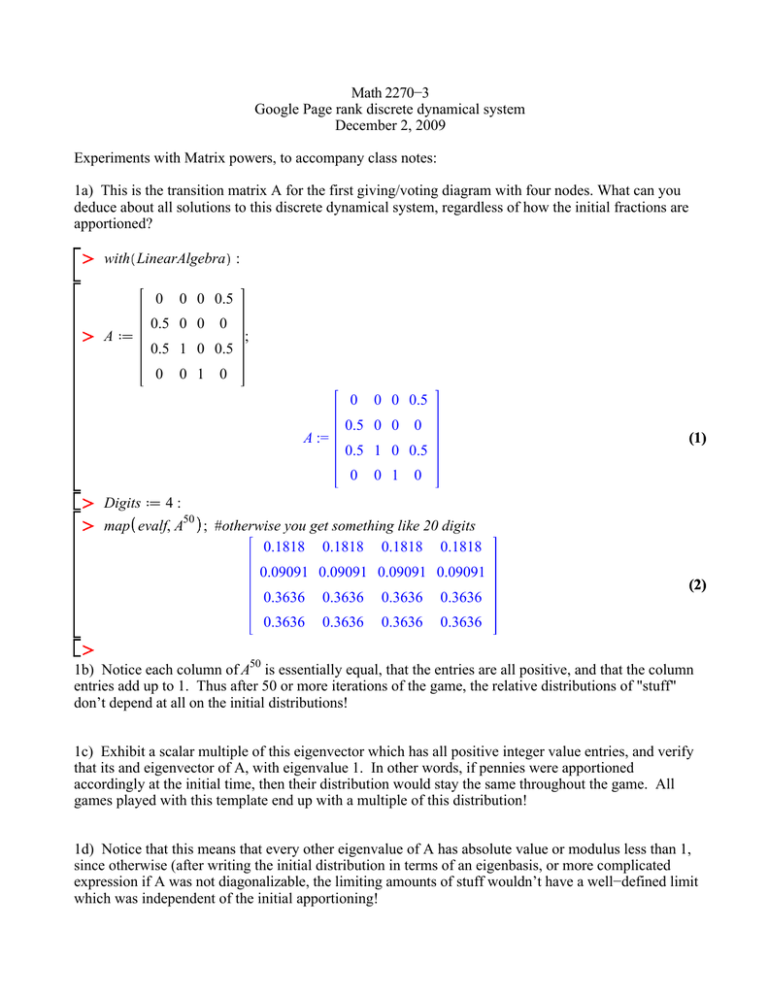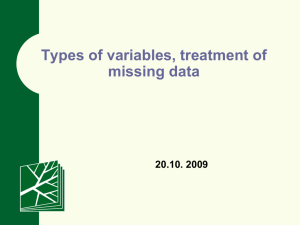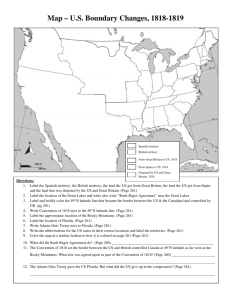Math 2270−3 Google Page rank discrete dynamical system December 2, 2009
advertisement

Math 2270−3 Google Page rank discrete dynamical system December 2, 2009 Experiments with Matrix powers, to accompany class notes: 1a) This is the transition matrix A for the first giving/voting diagram with four nodes. What can you deduce about all solutions to this discrete dynamical system, regardless of how the initial fractions are apportioned? with LinearAlgebra : 0 A 0 0 0.5 0.5 0 0 0 0.5 1 0 0.5 0 0 1 ; 0 0 A := 0 0 0.5 0.5 0 0 0 (1) 0.5 1 0 0.5 0 0 1 0 Digits 4: map evalf, A50 ; #otherwise you get something like 20 digits 0.1818 0.1818 0.1818 0.1818 0.09091 0.09091 0.09091 0.09091 0.3636 0.3636 0.3636 0.3636 0.3636 0.3636 0.3636 0.3636 (2) 1b) Notice each column of A50 is essentially equal, that the entries are all positive, and that the column entries add up to 1. Thus after 50 or more iterations of the game, the relative distributions of "stuff" don’t depend at all on the initial distributions! 1c) Exhibit a scalar multiple of this eigenvector which has all positive integer value entries, and verify that its and eigenvector of A, with eigenvalue 1. In other words, if pennies were apportioned accordingly at the initial time, then their distribution would stay the same throughout the game. All games played with this template end up with a multiple of this distribution! 1d) Notice that this means that every other eigenvalue of A has absolute value or modulus less than 1, since otherwise (after writing the initial distribution in terms of an eigenbasis, or more complicated expression if A was not diagonalizable, the limiting amounts of stuff wouldn’t have a well−defined limit which was independent of the initial apportioning! 5) Matrices and powers from other giving diagrams, to verify your predictions: a) 0 B 0 0 0.5 0.5 0 0 0 0.5 0 0 0.5 0 0 1 : map evalf, B50 ; 0 0.0003334 0. 0.0005899 0.0005219 0.0001885 0. 0.0003334 0.0002950 0.0005219 0. 0.0009233 0.0008168 (3) 0.0005899 0. 0.001044 0.0009233 b) 0 C 0 0 0.5 0.5 1 0 0 0.5 0 0 0.5 0 0 1 : map evalf, C50 ; 0 0.0003334 0. 0.0005899 0.0005219 0.9986 1. 0.9974 0.9977 0.0005219 0. 0.0009233 0.0008168 (4) 0.0005899 0. 0.001044 0.0009233 c) 0 0 0 .5 0 0 .5 0 0 0 0 0 E .5 1 0 .5 0 0 0 0 1 0 0 0 : map evalf, E50 ; 0 0 0 0 0 1 0 0 0 0 1 0 0.1818 0.1818 0.1818 0.1818 0. 0. 0.09091 0.09091 0.09091 0.09091 0. 0. 0.3636 0.3636 0.3636 0.3636 0. 0. 0.3636 0.3636 0.3636 0.3636 0. 0. 0. 0. 0. 0. 1. 0. 0. 0. 0. 0. 0. 1. (5) d) 0 0 0 .5 0 0 .5 0 0 0 0 0 F .5 1 0 .5 0 .5 0 0 1 0 0 0 : map evalf, F50 ; 0 0 0 0 0 .5 0 0 0 0 1 0 0.1818 0.1818 0.1818 0.1818 0.1818 0.1818 0.09091 0.09091 0.09091 0.09091 0.09091 0.09091 0.3636 0.3636 0.3636 0.3636 0.3636 0.3636 0.3636 0.3636 0.3636 0.3636 0.3636 0.3636 0. 0. 0. 0. 2.980 10−8 0. 0. 0. 0. 0. 0. 2.980 10−8 (6) 7) configuration (5c) with a google−like fudge factor to make the matrix stochastic: 1 1 1 1 1 1 1 1 1 1 1 1 ONE 1 1 1 1 1 1 1 1 1 1 1 1 : Eg .7 E .05 ONE : 1 1 1 1 1 1 1 1 1 1 1 1 map evalf, Eg ; map evalf, Eg50 ; 0.05000 0.4000 0.4000 0.05000 0.05000 0.05000 0.05000 0.05000 0.7500 0.05000 0.05000 0.05000 0.05000 0.05000 0.05000 0.7500 0.05000 0.05000 0.4000 0.05000 0.4000 0.05000 0.05000 0.05000 0.05000 0.05000 0.05000 0.05000 0.05000 0.7500 0.05000 0.05000 0.05000 0.05000 0.7500 0.05000 0.1249 0.09371 0.2342 0.2139 0.1667 0.1667 0.1249 0.09371 0.2342 0.2139 0.1667 0.1667 0.1249 0.09371 0.2342 0.2139 0.1667 0.1667 0.1249 0.09371 0.2342 0.2139 0.1667 0.1667 0.1249 0.09371 0.2342 0.2139 0.1667 0.1667 0.1249 0.09371 0.2342 0.2139 0.1667 0.1667 (7)




